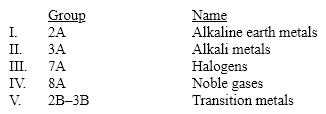A) 2
B) 6
C) 8
D) 10
E) 18
Correct Answer

verified
Correct Answer
verified
Multiple Choice
Which of these groups is incorrectly matched with its group/family name? 
A) I
B) II
C) III
D) IV
E) V
Correct Answer

verified
Correct Answer
verified
Multiple Choice
How many electrons are there in 15 N 3 − ?
A) 15
B) 18
C) 12
D) 4
E) 10
Correct Answer

verified
Correct Answer
verified
Multiple Choice
Calculate the number of moles in a 2.98 g sample of aluminum.
A) 0.0124 moles
B) 0.110 moles
C) 80.4 moles
D) 1.79 × 1024 moles
E) 1.62 × 1025 moles
Correct Answer

verified
Correct Answer
verified
Multiple Choice
Which of these is the correct chemical symbol for potassium?
A) K
B) Po
C) P
D) Pd
E) Pt
Correct Answer

verified
Correct Answer
verified
Multiple Choice
Which of the following elements is not a nonmetal?
A) P
B) I
C) N
D) K
E) Cl
Correct Answer

verified
Correct Answer
verified
Multiple Choice
What is the total number of electrons that can occupy the first and second principal energy levels ( n =1, n =2) ?
A) 2
B) 6
C) 8
D) 10
E) 18
Correct Answer

verified
Correct Answer
verified
Multiple Choice
Chlorine has two isotopes, 35Cl and 37Cl, whose respective abundances are 75.77% and 24.23% and masses are 34.9688 amu and 36.9659 amu. Calculate the atomic mass of chlorine.
A) 37.54 amu
B) 36.65 amu
C) 35.45 amu
D) 34.97 amu
E) 36.97 amu
Correct Answer

verified
Correct Answer
verified
Multiple Choice
Determine the mass in grams of one molecule of water, H2O.
A) 2.99 × 10 − 23 g
B) 1.08 × 1025 g
C) 10 grams
D) 18 grams
E) None of these.
Correct Answer

verified
Correct Answer
verified
Multiple Choice
Carbon has three isotopes: 12 C, 13 C, and 14 C. If the atomic number of carbon is 6, t hese isotopes each have _____, _____, and _____ neutrons, respectively.
A) 6; 7; 8
B) 6; 7; 8.0
C) 12; 13; 14
D) 12.0; 13; 14
E) 24; 25; 26
Correct Answer

verified
Correct Answer
verified
Multiple Choice
Calculate the number of moles in a 233-gram sample of barium.
A) 0.589 moles
B) 1.70 moles
C) 3.20 × 104
D) 6.022 × 1023 moles
E) 1.02 × 1024 moles
Correct Answer

verified
Correct Answer
verified
Multiple Choice
The atomic mass of fluorine (F) is 19.00. Which of the following is not true?
A) An atom of F has a mass of 19.00 amu.
B) One mole of F has a mass of 19.00 g.
C) The mass of 6.02 x 1023 atoms of F is 19.00 g.
D) The mass of 6.02 x 10 23 atoms of F is 19.00 amu.
E) The approximate total number of protons and neutrons in fluorine is 19.
Correct Answer

verified
Correct Answer
verified
Multiple Choice
The elements Li, Na, K, Rb, and Cs are the members of which group/family?
A) Halogens
B) Noble gases
C) Alkali metals
D) Transition metals
E) Alkaline earth metals
Correct Answer

verified
Correct Answer
verified
Multiple Choice
Determine the mass in grams of 3.45 × 1025 molecules of oxygen, O2.
A) 0.556 grams
B) 57.2 grams
C) 458 grams
D) 916 grams
E) 1.83 × 103 grams
Correct Answer

verified
Correct Answer
verified
Multiple Choice
The most abundant element in the Earth's crust by mass is _____.
A) hydrogen
B) carbon
C) oxygen
D) silicon
E) nitrogen
Correct Answer

verified
Correct Answer
verified
Multiple Choice
Which of the following is true?
A) Argon and chlorine have the same number of electrons.
B) Argon and chlorine have the same number of valence electrons.
C) Argon and neon have the same number of electrons.
D) Argon and neon have the same number of valence electrons.
E) Argon and helium have the same number of electrons.
Correct Answer

verified
Correct Answer
verified
Multiple Choice
The Cl − ion contains _____ protons and _____ electrons.
A) 17; 17
B) 17; 18
C) 18; 16
D) 18; 18
E) 16; 17
Correct Answer

verified
Correct Answer
verified
Multiple Choice
Bromine is a member of which group/family?
A) Halogens
B) Noble gases
C) Alkali metals
D) Transition metals
E) Alkaline earth metals
Correct Answer

verified
Correct Answer
verified
Multiple Choice
How many atoms does one mole of aluminum contain?
A) 12
B) 26.98
C) 6.022 × 1023
D) 12.044 x 1023
E) 14
Correct Answer

verified
Correct Answer
verified
Multiple Choice
The atomic number is abbreviated as _____.
A) A
B) N
C) E
D) P
E) Z
Correct Answer

verified
Correct Answer
verified
Showing 61 - 80 of 88
Related Exams